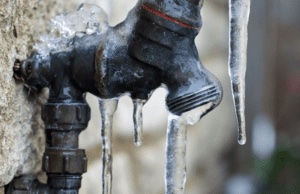Each year, homeowners experience problems with pipes in their homes freezing and issues stemming from winter weather. Over time across Texas, in such cities as Austin and San Antonio, homes and businesses begun to experience drastically colder temperatures. As a result, we want to prepare you for the months ahead. Cold-weather plumbing problems can possibly be avoided when a homeowner winterizes plumbing in their house. We gathered a list of tasks that will help you prepare!
If you want a professional plumber to help your home be “winter-ready”, we have a $250 special that includes insulation of the water heater and expert advice from our local plumbers.
- Locate and Flag homeowner shut off valve
- Inspect and insulate water heater
- Provide and install 2 hose bib covers
- Inspect and insulate RPZ
- Check water pressure
- Tech will provide info on how to shut off the valve and other winter-ready needs.
“Steven and Jason F came out and helped us winterize our home to get ready for the upcoming freeze. Both gentlemen were very knowledgeable and professional. We will definitely utilize Reliant Plumbing services moving forward! Great experience!” – Ross in San Antonio
Insulate Pipes
When winterizing plumbing, it’s important to wrap pipes in any area of your home that’s not heated. Pipe insulation, as well as heat tape, can be purchased at a local hardware store.

Check Water Pressure
It is possible to check a home’s water pressure with a water pressure gauge that can be purchased from a local hardware store. At Reliant Plumbing, we recommend a home’s water pressure be between 40 and 80 pounds per inch (PPI). If you do not have proper water pressure or don’t know how to check, contact us for an inspection! Excessive water pressure can cause damaged pipes as well as breaking faucets and valves.
Plan for Winter Travel
Traveling during the winter months is common, and nobody wants to go on a trip and worry about their pipes bursting! Reliant Plumbing recommends homeowners do these 3 things to minimize potential plumbing problems when traveling.
- Drain all the water out of the home’s pipes. This can be done by turning off a home’s main water supply. Then open all the spigots and faucets in the home until the water stops coming out.
- Maintain the home’s heat a bit above where it is normally kept. This will help prevent pipes from freezing. It will also make certain your home’s indoor air temperature is always above freezing.
- Turn off the main water supply until you return.
Check Your Water Heater
The last thing you want to deal with in the middle of winter is a broken water heater! A standard water heater usually needs to be replaced every 10 to 12 years. Upgrading to a new water heater is often considered to be a significant investment, but it is better than dealing with a failed unit during the cold months. Upgrading will also help you avoid the chances of having a water heater burst and flood a basement, a laundry room, or a garage when the temperature outside is well below freezing.
Check Your Sump Pump
A sump pump will help protect a home should there be flooding in the basement. When your home has a sump pump, it is important to make certain it is in good working order prior to cold temperatures arriving. The team at Reliant Plumbing can examine your home’s sump pump and make certain it is ready for the winter.
Drain Sprinkler System
If your home has a sprinkler system, it’s important to drain sprinklers prior to the arrival of colder temperatures. Doing this significantly decreases the chances of these pipes rupturing during the winter. All water hoses should be well-drained and stored indoors before the winter months arrive.


